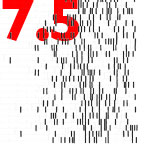CALLIGRAPHY
F. J. Bergmann
I wanted my signature to coil around me, a fainting snake, ascending lemniscates in gold, the swirled arabesque of welts that a fingernail idly traces on a lover’s skin, a recurved bow with extra strings, whiplash weave, or maybe something analogous to a grid of bones, a basket of soft thighs, a tasselled pillow bearing a ballet slipper filled with hydrofluoric acid, a 1:200 scale model of a coal-burning utility plant not yet downgraded to meet Clean Air Act standards, a King James Bible with the naughty bits highlighted in pink marker, a large duck, wings outspread, chasing a small dog. Someday I’ll learn to write in cursive.
__
In 1960, just before I was due to start kindergarten, we moved to Paris, France, where I attended a Montessori school. Although permanently traumatized by a sink-or-swim approach to French-language immersion (none of the staff or other students spoke any English to speak of, as it were), I learned enough to advance directly to 4th grade when we returned to the States two years later. Cursive penmanship had been covered earlier in the American syllabus, and I never quite caught on, preferring to write all my homework in minuscule (not intended as a synonym for lower-case in this instance) block letters—tight, tiny, and dysfunctional. I secretly envied those whose handwriting ran together in fluid, elegant curves and finally developed a looser, messier version of printing, approaching the speed, if not the aesthetics, of cursive. My signature is now a wavy line.
